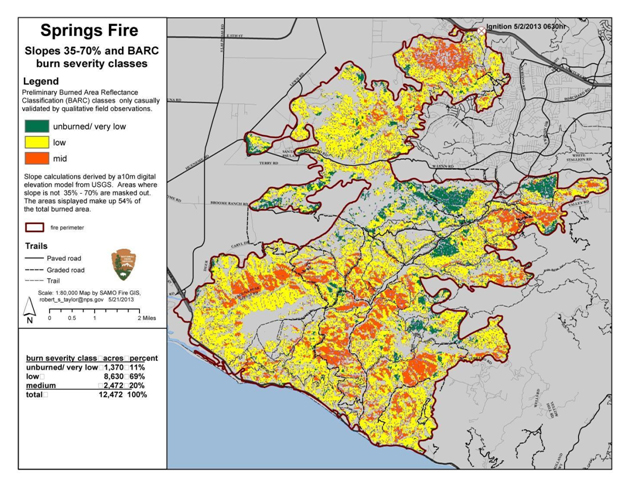On February 11, 2013, Santa Monica Mountains National Recreation Area (SAMO) staff cheered when we saw rocket contrails from the launch of Landsat 8 a few miles north of the park. Barely 3 months later, the Springs Fire (May 2, 2013) burned 25,000 acres of parkland, and NPS GIS and remote sensing specialists were using the very first publicly released Landsat 8 images to map burn severity. Maps visualizing Burned Area Reflectance Classification (BARC) imagery helped park scientists and resource managers assess effects of the Springs Fire. Later that season, NPS did the same thing for the much smaller Old Fire (August 18, 2013). BARC provides a sensitive, spatially detailed, but unitless measure of how much vegetation is consumed by a fire. A geomorphologist used BARC imagery immediately after the fire to assess soil erosion potential for the Burned Area Emergency Rehabilitation (BAER) program. This map (below) combines standard classes of burn severity values derived from the BARC image with requested classes of slope steepness values derived from a digital elevation model (DEM) to provide the geomorphologist with needed inputs for sediment yield calculations. The map shows where critically steep slopes are located and how much vegetative cover was lost there. Steep slopes with high burn severity values are especially vulnerable to soil erosion in the post-fire environment. Over the next several months, fire ecologists combined BARC imagery with prefire vegetation, road, trail, and terrain data, using GIS to determine where to locate and collect field data from several hundred burn severity field plots. When the BARC imagery is calibrated with ground-based field plot data, we can make meaningful comparisons of fire effects from multiple fires burning under a range of weather and fuel conditions. We are especially interested in the effects of the Springs Fire because it was quite unseasonable and occurred during the worst drought in at least a century.
http://www.nps.gov/samo/parkmgmt/firemanagement.htm

Burn severity and slope steepness are inputs for calculations of sediment yield from burned watersheds.

